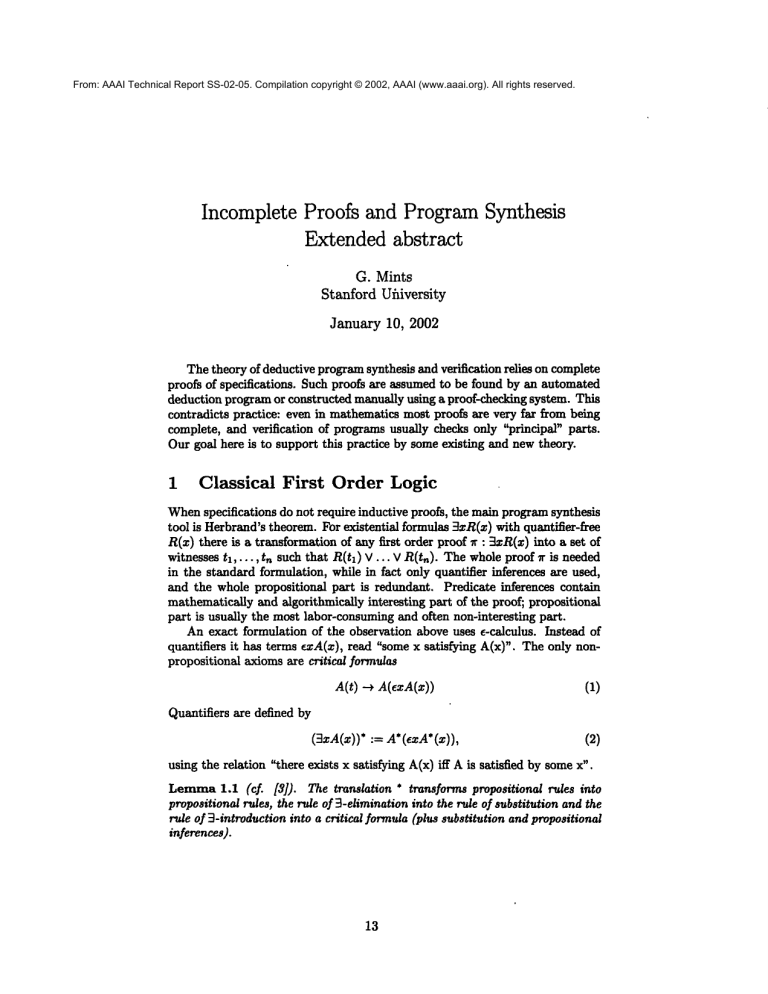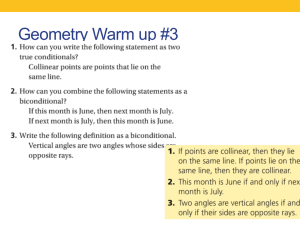
From: AAAI Technical Report SS-02-05. Compilation copyright © 2002, AAAI (www.aaai.org). All rights reserved.
IncompleteProofs and ProgramSynthesis
Extendedabstract
G. Mints
Stanford Ufiiversity
January l0, 2002
Thetheory of deductiveprogramsynthesis and verification relies on complete
proofs of specifications. Suchproofs are assumedto be found by an automated
deduction programor constructed manuallyusing a proof-checkingsystem. This
contradicts practice: even in mathematicsmost proofs are very far from being
complete, and verification of programsusually checks only "principal" parts.
Our goal here is to support this practice by someexisting and newtheory.
1
Classical
First Order Logic
Whenspecifications do not require inductive proofs, the mainprogramsynthesis
tool is Herbrand’stheorem.For existential formulas3xR(x)with quantifier-free
R(z) there is a transformationof any first order proof lr : 3zR(x) into a set of
witnesses tl,..., tn such that R(tl) V... R(tn). The whole proof ~ris needed
in the standard formulation, while in fact only quantifier inferences are used,
and the wholepropositional part is redundant. Predicate inferences contain
mathematicallyand algorithmically interesting part of the proof; propositional
part is usually the most labor-consumingand often non-interesting part.
An exact formulation of the observation above uses e-calculus. Instead of
quantifiers it has terms exA(z), read "somex satisfying A(x)". The only
propositional axiomsare critical formulas
A(t) -~ A(ezA(x))
(1)
(BzA(x))* A*(ezA*(x)),
(2)
Quantifiers are defined by
using the relation "there exists x satisfying A(x)iff A is satisfied by somex".
Lemma
1.1 (cf. [3]). The translation * transforms propositional rules into
propositionalrules, the rule of 3-eliminationinto the rule of substitution andthe
rule of B-introductioninto a critical formula(plus substitution and propositional
inferences).
13
After that the first e-theorem (cf. [3]) allows us to find instances for existential 3xR(x) depending only on critical formulas Cr that tautologically imply
2
Constructive
Proofs
The main pragmatic reason for having constructive or intuitionistic
proofs is a
possibility to extract programs from proofs ~r : 3xA(x) without any restriction
for A(x). In this new logic one cannot completely ignore the propositional part
of lr: implications contribute significantly into the complexity of the eventual
program. Most program extraction methods here are based on functional interpretation that are based on Brouwer-Heyting-Kolmogorovinterpretation
of
constructive logical connectives. These interpretations differ in the amount of
information they need. For example modified realizability mr, a functional interpretation introduced by G. Kreisel, ignores negative premises of implications:
Another manifestation
of the same phenomenonis Harrop’s theorem.
Theorem2.1 For arbitrary A,B, if-,A -¢ 3zB(z) is derivable (in intuitionistic first or higher order logic, intuitionistie first or higher order arithmetic etc.),
then -~A ~ B(t) for some t is derivable in the same theory.
In fact -~A can be replaced by any V, B-free formula C. Proofs of such
lemmas C, even of number-theoretic identities,
to say nothing about Riemann
Hypothesis or Fermat’s Last Theorem, can be very complicated, but they can
be skipped if we are interested only in the program.
3
Arithmetic;
-substitution
Method
In the case of classical arithmetic, the most venerable methodof extracting witnesses from the proofs of purely existential formulas 3xR(x) with quantifier-free
R(x) is Hilbert’s e-substitution method, [3, 5]. It works after the *-translation
(2) was applied to extract from a given proof ~r a finite system Cr of critical
formulas. The method generates a sequence of e-substitutions
So,sl,...
(3)
Each of Si has a form
(eZlAl,nl),...,
(e~lAk,nk)
(4)
for natural numbershi,..., n/¢. The goal is to find an e-substitution (4) solving
given system Cr of critical formulaq, that is makingCr true after a substitution
( exl A1 In1 .... , ex 1Ak Ink) and computation. If an implication Cr -¢ R(e~R(x)
14
isderivable
without
useof critical
formulas,
sucha solving
substitution
provides
an n satisfying
R(n).
W. Ackermann
provedtermination
of thee-substitution
methodfor arithmetic.
Hisproofis notsimple(G.Kreisel
considered
it to be a version
of the
priority
method)and resistsextension
to stronger
systems.
A new approach
proposedby the presentauthoradmitsextension
to strongersystemsusing
infinitary proofs in e-calculus [5]. Expansion of a linear sequence (3) into
two-dimensional infinitary proof h°° adds new intuitions and enables new geometrical constructions,
but seems to prevent computational treatment. We
describe below such a treatment using incomplete proofs.
Consider a new formal system PAe. in the language of arithmetical e-terms.
Derivable objects are sequents
(5)
where ei are closed arithmetical e-terms containing no proper closed e-subterms,
and ui E {?, ?0, +} U1N.A sequent contains at most one component of the form
(e, +). Such a component provides an incomplete information to be replaced
later by a natural number, resulting in (e,n). A "proof" of a sequent (e, +),
can be simply an axiom AxA((e, +), O), promising a proof of a suitable sequent
(e,n),O for some n E 1N in the future. In this sense proofs in PAe* are incomplete. Exact definitions below use notation from [5].
Definition 1 Two sequents E and 0 are multiplicable if O U ~2 /s a function
after identification (e, ?o) ~-.,t= (e, ?) and (e, +) ~=(e, n) if the latter is present.
In this ease we write 0 * E for 0 U E.
Axioms
AxF(e)
O is ci
O is solving
AxS(O)
AxH~,,,(B)e is the H-term, v is the H-value of O
AxA(e) O is an arbitrary sequent
Rules of inference
(e, ?0),
O (e, +),e
O
Cute
(e,?),e (e,+),e
(e, ?0), T(e, +),
(e, ?),
(e,?),O
O
Fre
O
O
T * O Re_
(e,v),O<_rk(e) He,~
(e, ?),
CutFre
O
~ D
O W~.
~* O
An ordinal assi~nment for a derivation h is defined with a path lr for the endsequent of h as an additional argument. In fact lr is used only in Re-ease, and
weomititin allothercases.
15
Definition 2 Let 60 = 1, if (e, +) occurs in O, and e is needed for computing
truth-values of critical formulas or the neat e-substitution; 60 = 0 otherwise.
if h -- AxX(O),
x#A
I
Nlc~(e)le
+ 1[to+ Nlcrl
e - 6e
o(h) := ~ o(hl) + length(=) + 1 + o(ho)
wo(ho)
I
/m=Co(h0),
O(hl)) -F
if h = AxA(O), computes Cr
if h = AxA(O)otherwise
if h = Rehohl
if h = E,ho~
if h =- Cutehohl, CutFrhohl
if h = Tho, T =-- Fr, H,D,W
/o(ho) +
Theorem 3.1 Every se4uenee (4) generated by the e-substitution
method can
be effectively transformed into a sequence of proofs ho : So, hi : S,,... such that
o(ho) > O(hl) > .... Hence e-substitution method terminates.
Ordinal assignment o(h) and the construction of proofs hi use ideas from [4] and
definitions from [1]. It is natural to expect that these constructions and proofs
can be extended to all subsystems of analysis (second order arithmetic) admitting proof-theoretic ordinal analysis via cut-elimination. This will constitute a
progress in problem stated by D. Hilbert in [2].
References
[1] W. Buchholz, Explaining Gentzen’s Consistency Proof within hfinitary
Proof Theory, in: Gottlob, G., Leitsch, A., Mundici, D. (eds.) Computational Logic and Proof Theory. 5th Kurt GSdel Colloquium, KGC’97
Lecture Notes in Computer Science, Vo1.1289. Springer 1997
[2] D.Hilbert,
102, 1-9
Probleme der Grundlegung der Mathematik, Math.Ann. 1929,
[3] D.Hilbert, P.Bernays, Grundiagen der Mathematik, Bd.2, Springer, 1970
[4] G. Mints, Finite Investigations of Transfinite Derivations, J.Soviet Mathematics, 1978, 10, 548-596 (Russian original 1975)
[5] G. Mints, S. Tupallo, W. Buchholz, Epsilon Substitution Method for Elementary Analysis, Archive for Math. Logic (1996), 35, 103-130
16


